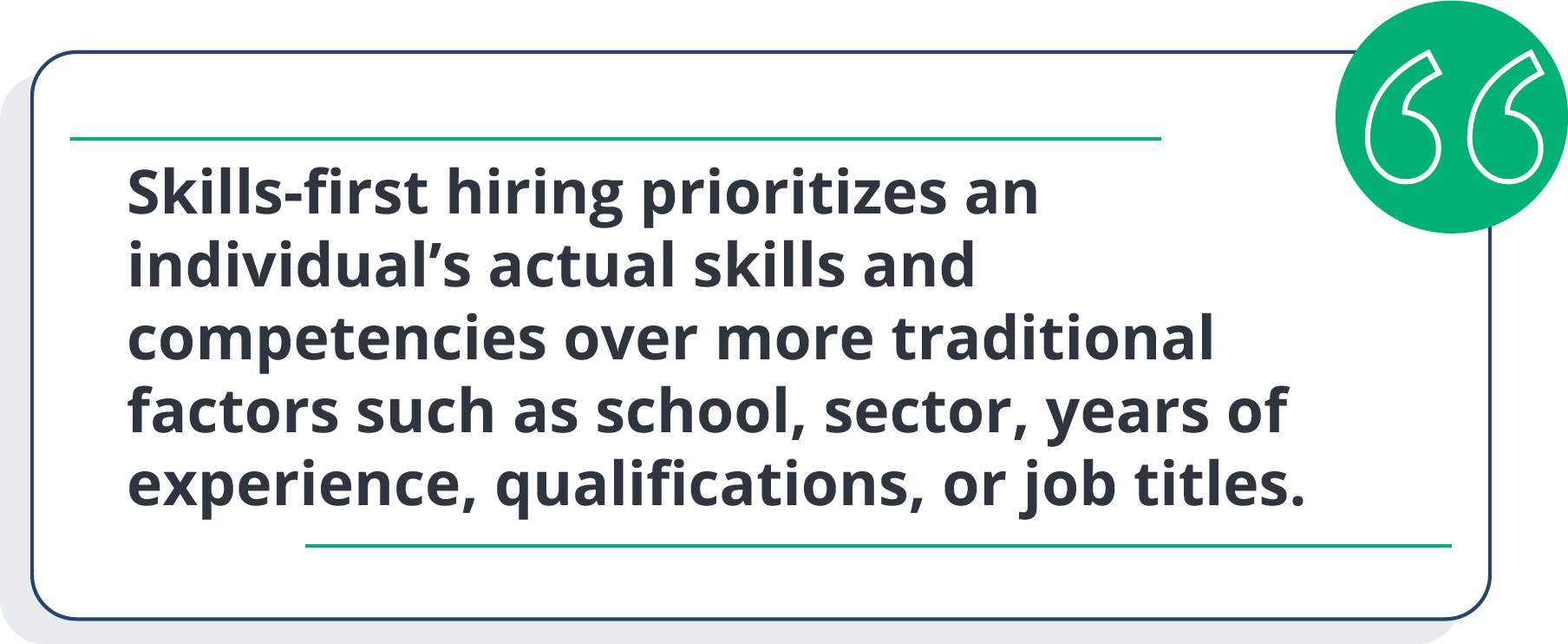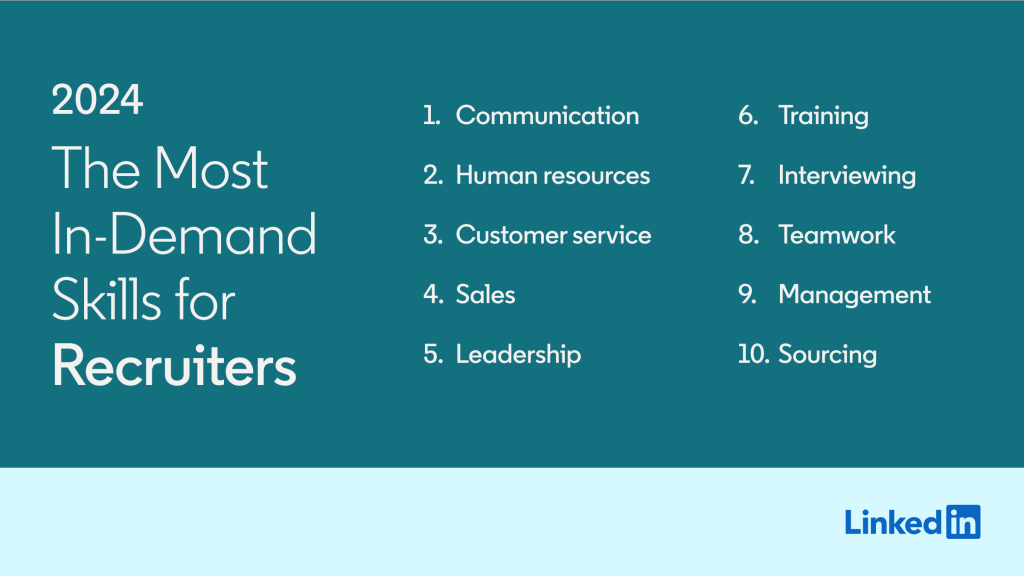There’s no doubt that AI-powered tools are changing how talent sourcers and recruiters operate across the entire recruitment cycle. AI’s machine learning capabilities and pattern recognition are advancing how we identify, engage, and hire candidates.
So, what are the big AI recruiting trends for 2024 and beyond? As AI innovation accelerates, it could be anyone’s guess, but here’s our take on what to look out for.
Trend 1: AI Enablement of Skills-First Recruitment
Skills-First Hiring

No surprise here. Skills-first recruitment is an approach that has the potential to fill the skills gap by stripping out bias and other barriers in order to expand the talent pool, which LinkedIn suggests may increase by tenfold.
And there’s more. In addition to a chunkier talent pool, other benefits from skills-first hiring include:
- A more diverse workforce resulting from the skills of previously underrepresented or non-traditional candidates becoming visible.
- A less biased, more accessible recruitment cycle.
- Greater retention, as skills-first candidates have a proven track record with the skills they need for their new role. They’re more likely to succeed.
“Skills are the thread that pulls our candidate and employee life cycle together. And as we reshape our talent strategies, we need to think expansively about knowledge, skills, and abilities and grapple with the critical importance of understanding skill proficiencies.”
—Jennifer Shappley VP, Talent at LinkedIn.
According to research by Veris Insights, companies using skills-first hiring experienced reduced time-to-hire, cost-per-hire and an increase in diversity hiring.
How AI Empowers Skills-First Hiring
AI-powered tech gives you the capability, capacity, and speed to search and hire for skills at each stage of the recruitment cycle. It does this by:
- Analyzing skills and skill gaps in an organization as a basis for skills-based talent sourcing.
- Generating skills-based job descriptions.
- Identifying best-fit candidates through skills matching.
- Reducing unconscious bias by removing images and parsing resumes.
- Creating, managing, and analyzing skills-based assessments as part of the screening process.
Trend 2: The Empowerment of Soft Skills Development
AI-powered recruitment tools are continuing to relieve recruiters of much of the recruitment grunt work. As more laborious manual tasks like writing job descriptions, job postings, and answering individual candidate queries quickly become prehistoric, recruiters and sourcers will have more bandwidth to develop in-demand soft skills.
In addition, AI’s capability to sift data, recognize patterns, and make connections empowers recruiters with data insight that can help them elevate their roles to become more strategic or pivot to a specialty, like sourcing for DEI.
And, of course, AI is simply not suited for some tasks. Paradoxically, the rise of AI also means some roles place a greater premium on non-AI skills. Human connection lies at the heart of effective recruitment. Only humans can do this, which is why one of the top in-demand soft skills is communication.
Other soft skills on the rise include sales, leadership, management, and coaching – sometimes called upskilling. Empathy, critical thinking and relationship building will also be important. Among these softer skills, LinkedIn recently identified talent sourcing as No. 10 on a list of the most sought-after skills for recruiters in 2024.

Trend 3: Combating Candidate Cheating
We all want to live in a world where honesty and integrity are standard parts of the recruitment process (on both sides), but unfortunately candidate cheating exists. With the prevalence of remote hiring, how can you tell if a candidate is representing their skills and knowledge truthfully?
Common ploys include faking an ID, lying about qualifications, and exaggerating work experience, and there are plenty of ways to cheat on screening assessments.
Candidates may use generative AI like ChatGPT to answer screening questions or solve problems. Some may not take an assessment at all, because a friend has done it for them.
Increasingly, AI tools are being leveraged to safeguard the recruitment process against fraud and cheating by:
- Verifying candidate identity.
- Identifying anomalies in the screening process – multiple faces on screen or multiple open tabs could indicate cheating.
- Identifying a change of IP address – which could indicate a VPN or another person taking the assessment.
- Checking for plagiarism in answers to open questions.
- Identifying the route a candidate took to solve a problem: did it make sense?
Of course, you must first define what cheating means to you and what skills you’re testing for. Using ChatGPT to answer questions doesn’t necessarily indicate cheating. For instance, many coders use ChatGPT (or other genAI bots) as an efficiency shortcut. Some industries would consider it ridiculous not to use such tools.
Trend 4: The Democratization of Recruiting
AI recruiting tools are fast becoming accessible technology that anyone can use. This benefits smaller businesses and startups that haven’t traditionally been able to compete with bigger companies for the best talent.
Pre-COVID, 73% of small businesses felt challenged by competing with better-known companies, but since that time, AI has exploded. That was then. This is now. The barriers are down.
The opportunities AI tools can leverage in terms of accessibility, price, and user-friendliness have put more recruitment power in the hands of the hirers themselves. You no longer need big bucks or a tech-savvy team to find those best-fit candidates.
Of course, the quality of results will depend upon access to quality data and the user’s skill levels, but accessibility and cost are no longer an issue for many.
Increasingly, generative AI tools, in particular, are helping people chat their way to the perfect hire. Users can create the required comms using genAI, starting with basic inquiries like “I need a senior sales agent experienced in EMEA. How do I get started?”
Recruiters can leverage more advanced user prompts with purpose-built recruiter co-pilots, like our sister brand Hopward, a ChatGPT-like interface with ready-made access to Visage’s pool of passive talent. From simple chats to more complex configurations, AI-powered tools are able to (figuratively) hold a user’s hand throughout the stages of identification, engagement and hiring.
AI Recruiting Trends: What Next?
The fun part of AI is the rate of development and the dazzling array of potential applications. There will always be something new to play with, but, whatever happens, the traditional gatekeepers of recruitment won’t be able to stop the tide of progress.
AI gives candidates the tools to streamline their job search and get their resume in front of thousands of recruiters, and that same AI offers small businesses the opportunity to find a best-fit hire cheap and fast. We couldn’t be happier.
At Visage, we’re supporting democratization by offering our Visage Autopilot, a sourcing strategy that helps you search less, hire more, and (of course) stay human. Find out more about it here or reach out for a demo.

Director of Sourcing Operations at Visage, Evelyn has experience in agency, RPO, and in-house roles spanning 12 years in the recruitment industry. Evelyn has built and oversees a 4000-member global freelance sourcing community. Every Christmas in Ireland, she enjoys putting up her THREE Christmas trees.

